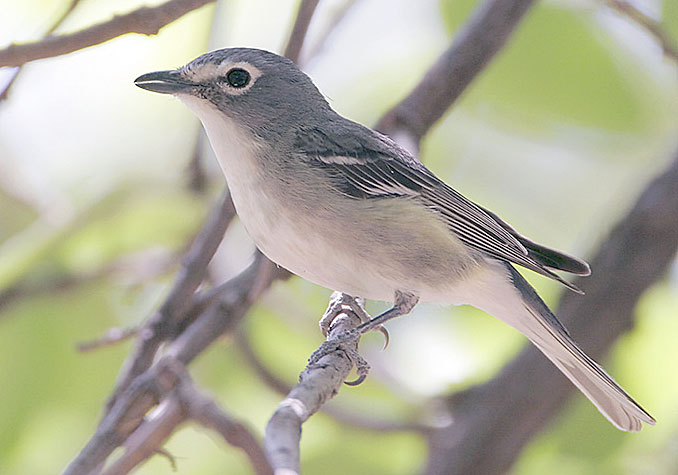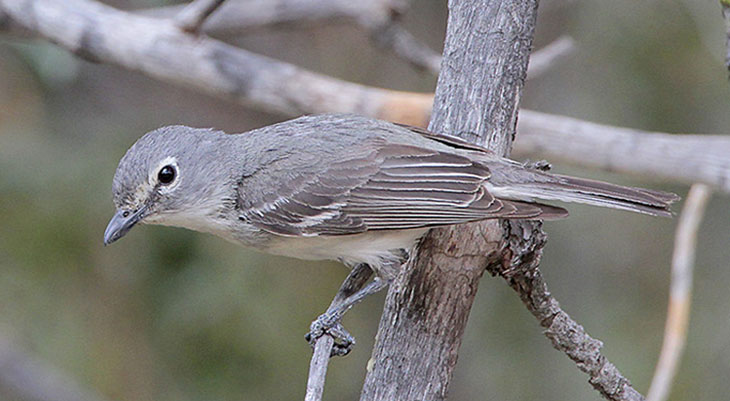Formerly considered conspecific with Blue-headed and Cassin’s Vireo and called the Solitary Vireo, the Plumbeous Vireo is a solitary migrant that breeds in parts of the western U.S. Nest parasitism by the Brown-headed Cowbird is very common, reaching over 80 percent of nests in one study.
The male Plumbeous Vireo brings his mate to a potential nest site and begins attaching spider silk to a branch. If the female accepts the location, both birds will begin constructing the nest, though after about two days the male stops helping. He does help incubate the eggs once they are laid.
On this page
Description of the Plumbeous Vireo
BREEDING MALE
The Plumbeous Vireo has a gray head and upperparts, white spectacles, whitish underparts, and gray wings with two white wing bars.

Photograph © Greg Lavaty
Female
The sexes are similar.
Seasonal change in appearance
None.
Juvenile
Juveniles are similar to adults, but somewhat browner.
Habitat
Plumbeous Vireos inhabit pine and oak-juniper woodlands.
Diet
Plumbeous Vireos eat insects.
Behavior
Plumbeous Vireos forage rather deliberately in trees.
Range
Plumbeous Vireos breed across much of the southwestern U.S. and Great Basin. They winter in Mexico. The population appears to be increasing.
Fun Facts
The Cassin’s Vireo was formerly considered to be a subspecies of Solitary Vireo, a species since split into Plumbeous, Cassin’s, and Blue-headed Vireos. It is relatively little-studied.
During courtship, the male Plumbeous Vireo sways back and forth in a regular pattern.
Vocalizations
Calls include a harsh series of notes, while the song consists of a series of rough phrases.
Similar Species
- Cassin’s Vireos have greener upperparts and wings.
Nesting
The Plumbeous Vireo’s nest is a cup of leaves, weeds, bark fibers, and other plant materials, and is typically placed on a forked twig of a tree.
Number: Usually lay 4 eggs.
Color: White with darker markings.
Incubation and fledging:
The young hatch at about 14-15 days, and leave the nest in about another 13-15 days, though continuing to associate with the adults for some time
Bent Life History of the Plumbeous Vireo
Published by the Smithsonian Institution between the 1920s and the 1950s, the Bent life history series of monographs provide an often colorful description of the birds of North America. Arthur Cleveland Bent was the lead author for the series. The Bent series is a great resource and often includes quotes from early American Ornithologists, including Audubon, Townsend, Wilson, Sutton and many others.
Bent Life History for the Plumbeous Vireo – the common name and sub-species reflect the nomenclature in use at the time the description was written.
PLUMBEOUS VIREO
VIREO SOLITARIUS PLUMBEUS Coues
According to the 1931 Check-list, this dull-colored vireo “breeds from northern Nevada, northern Utah, southern Montana, northeastern Wyoming, and southwestern South Dakota south through Arizona and central western Texas to Chihuahua and the mountains of Vera Cruz.” It is thus the easternmost of the western races, and there seems to be no breeding race of the species in the center of the United States, that is, the Mississippi Valley region. The species, as a whole, seems to prefer cool, northern forests, mountain regions, or the cooler climate of the Pacific, to the hot dry interior of the country.
Ridgway (1904) describes the plumbeous vireo as “similar to L. s. alticola, but back and scapulars entirely gray; rump and upper tailcoverts gray, tinged with olive-green, and sides and flanks much more faintly washed with yellow.” The color pattern is the same as in the mountain vireo, the head being practically concolor with the back, but all the colors are much paler and grayer.
The plumbeous vireo is essentially a bird of the mountains and the mountain canyons, during the breeding season. In the Huachuca and the Chiricahua Mountains in Arizona, we found it fairly common in all the wooded canyons up to 7,000 feet, and less common among the pines at 8,000 or 9,000 feet near the summits. We saw the first one in the Chiricahuas on April 26, 1922. Mr. Swarth (1904) says that, in the Huachucas, it is quite abundant in all parts of the mountains during the spring migration, but not so numerous during the summer. In his paper on Arizona mountain birds, Dr. Edgar A. Mearns (1890) writes:
By its loud song this species is known to be a common denizen of the pine forests of this region; but It keeps so near the pine-tops as to be seldom seen, save by tracing to their source the sweet notes one almost constantly hears whcn riding through these grand forests it being one of the most persistent singers that I have met with. It often visits the spruce woods of the higher zone, a few perhaps breeding there.
In New Mexico, Mrs. Bailey (1928) records it as breeding as low as 6,000 feet in the Guadalupe Mountains, and as high as 8,000 feet “in the coldest part of the Zuni Mountains.”
Russell K. Grater writes to me from Zion National Park, Utah: “This is one of the commonest birds in the park during the summer months. Its habitat in the canyons is mainly confined to the boxelder and other broadleafï trees; here among these trees nesting birds are closely distributed for miles along the canyon floor.”
Nesting: On May 26, 1922, in a branch of Ramsay Canyon, in the Huachucas, we found a nest of the plumbeous vireo with the bird sitting on it; it was about 6 feet from the ground at the tip of a lower branch of a small oak growing on the steep mountainside that rose sharply from the bed of the canyon. I tried to photograph it, but the bird would not let me get near enough for a good picture. I was surprised to find the nest empty. The bird would not return to the nest in front of the camera; but after the camera was removed, she promptly returned and settled on the nest as if incubating. My companion, Frank C. Willard, collected this nest, with a set of four nearly fresh eggs, on June 4 and sent it to me. This nest., now before me in its faded condition, must have been a very pretty nest when fresh. The framework, presumably of the usual materials used by vireos, is entirely concealed externally by a great variety of mosses, lichens, and bits of plant down of varied colors, firmly interwoven with and secured in place by narrow strands of fine inner bark, probably cedar, other very fine fibers, numerous bits of fine string and apparently only a little spider silk; these materials completely envelope and conceal the two supporting twigs. It is neatly lined with very fine, yellowish grass tops, from which the seeds had been removed. Its external dimensions are 4 by 3½ in diameter and over 2 inches in depth (it was probably flattened some in packing) ; the inner cavity measures about 21/2 in diameter at the top and 11/2 inches in depth; the walls are nearly an inch thick in some places.
There is another set of four eggs in my collection, taken by 0. W. Howard in these same mountains on May 31, 1901; the nest was in a maple tree, hung from the fork of a small branch near the extremity of a limb, about 40 feet above ground.
Mr. Willard (1908) says of nests that he has seen in the Huachuca Mountains:
The nests are usually close to the ground, frequently within reaching distance. Oaks, ash, maples and sycamores are selected as nesting sites. Each pair has Its claim staked out and ejects all Intruders of the same species, altho the other two species are unmolested by Plumbeus even when nesting in close proximity.
In nest building they go as far as a quarter of a mile for material. They feed closer to the nest, however, probably at not over half this distance. The female does all the nest-building but is assisted somewhat by the male in the duties of Incubation. He also feeds his mate on the nest, hut this is done rather Infre. quently. My present observations give the time at intervals of from twenty minutes to half an hour. When doing so he sings close by the nest after feeding her and this has helped me locate several. The male also sings when the nest Is approached, and once this year I saw one sitting on the nest and singing. Toward evening the male frequently flies down close to the nest and sits within a few inches of it for long periods, being perfectly quiet and motionless all the time.
The nest Is a very pretty cup-shaped affair as Is usual with this family. It Is composed of grass-tops woven into a framework and filled in with oak down and greenish colored oak blossoms and bits of spiders web. Tho lining Is of fine grass tops from which all the seeds have been removed. The general appearance of a normal nest is greenish in color. One nest built in a sycamore was made entirely of white goat hair and fine grass. The hair hung down some inches In a fringe all over and made a handsome ornament.
In Zion National Park, Utah, according to Russell K. Grater (MS.), “nesting begins late in April and continues into June. The nests are uniformly close to the ground, usually being only about 4 to 6 feet up. Made up of fine grasses, bits of small shredded leaves, and the cotton from the poplar trees, it is one of the most perfectly constructed nests found in the region. The nest is invariably on the tip of a long branch, suspended from a fork, and is usually well shaded by other parts of the tree’s foliage. The parent birds call incessantly, even while bringing food to the young, becoming silent only when within a few feet of the nest.”
Eggs: The plumbeous vireo lays ordinarily three or four eggs, most commonly four, and rarely five. These are similar to the eggs of the species elsewhere. The measurements of 30 eggs in the United States National Museum average 20.2 by 14.9 millimeters; the eggs showing the four extremes measures 21.7 by 15.0, 21.4 by 15.5, and 18.3 by 14.2 millimeters.
In other respects all the habits of the plumbeous vireo seem to be very similar to those of the eastern blue-headed vireo and need not be reported here.


